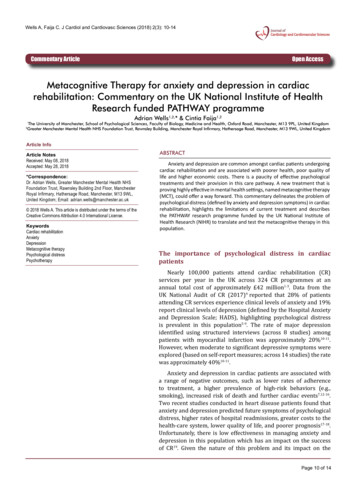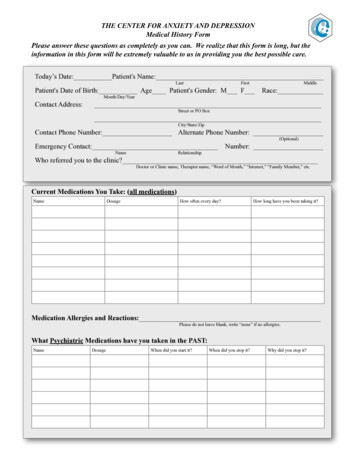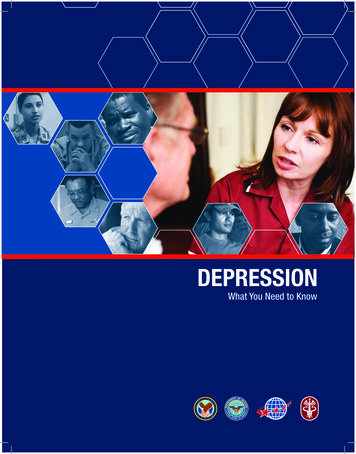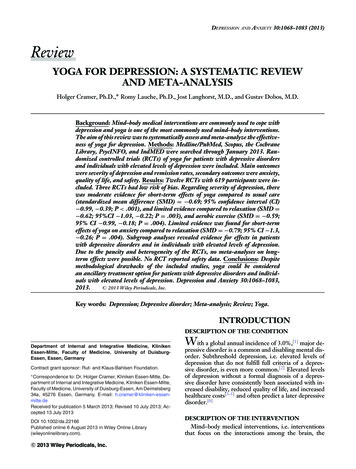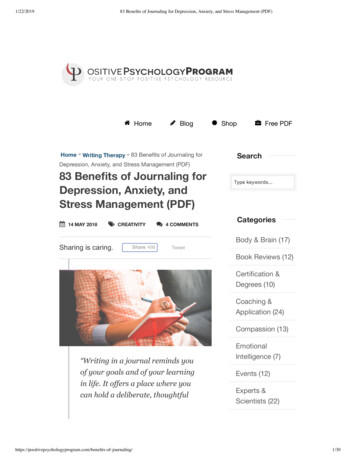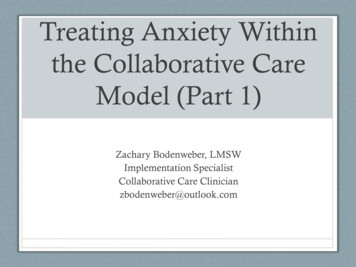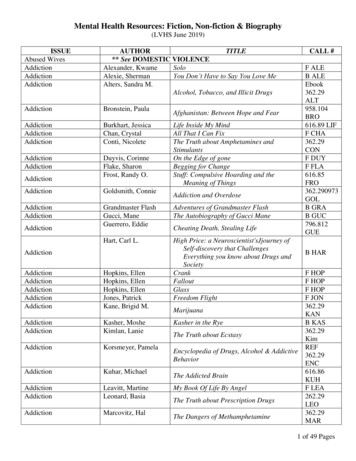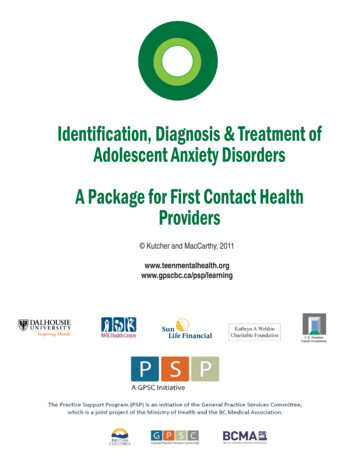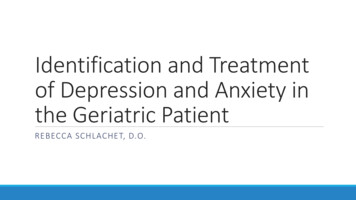
Transcription
Identification and Treatmentof Depression and Anxiety inthe Geriatric PatientREBECCA SCHLACHET, D.O.
Objectives Identification and treatment of depression inolder patients Identification and treatment of anxiety inolder patients
Who are these patients The most common definition is those greater than 65years old More likely to live at facilities ie. NH, ALF, ILF 80% have at least one chronic medical issue Usually present to PCP
Unique population Source of information Taboo regarding mental health issues Different terminology to describe depressed mood andanxiety Cognitive decline Ability to engage in treatment
Depression Depression is not a normal part of aging 1-4% of older people have MDD, women 2 times as likely Minor depression: 4-14 % older adults Dysthymia/PDD: 2% Hospital: MDD up to 12% Nursing home: MDD 14 %, clinically relevant depression 1735%Rojas-Fernandez et al. Considerations in the treatment geriatric depression. Research in Gerontological Nursing 2010; 3:3
Depression Symptoms vs. Disorder Be on the alert for signs and symptoms of depression Screening tools (PHQ9) Who treats depression in the elderly – up to 80% treatedby primary care Often depression is NOT identified or treated
Depression- Risk Factors Substance abuse Medications (ie. beta blockers, carbidopa, opioids) Hearing/vision impairment H/O depression Stress Medical conditions (CAD, COPD, MS, chronic pain, cancer,CVA, PD, cognitive impairment)
Depression-Risk Factors Insomnia Lower socioeconomic status Late onset depression- not more likely to report familyhistory
Depression in the Elderly- Characteristics Depressed mood less prevalent More likely to complain of decreased energy, anhedonia, poorappetite, insomnia, somatic concerns , pain, anxiety Signs of withdrawal, poor interest, low energy, cognitive impairment,weight loss Poor recovery after illness, poor adherence to rehab, refusal oftreatment “Depression without sadness”Rojas-Fernandez et al. Considerations in the treatment geriatric depression. Research in GerontologicalNursing 2010; 3:3
Considerations Medical evaluation as appropriate- labs, medical history,physical exam, brain imaging, medication review Psychosocial stressors. ie. Abuse, inadequate support,finances Waiting room paperwork- Brief screening tools (PHQ-9, 5item Geriatric Depression Scale)
DepressionS- Sleep disturbanceI- Interest diminishedG- guiltE- decreased energyC- impaired concentrationA- appetite/weight changeP- psychomotor disturbanceS- suicidal ideation
DSM V - Depression Major Depressive Disorder-severity-with or without psychosis Persistent Depressive Disorder Depressive disorder unspecified Adjustment disorder with depressed mood
Major Depressive Disorder At least 5 symptoms for at least 2 weeks that cause clinicallysignificant distress or functional impairment 1 symptom must be depressed mood or loss ofinterest/pleasure Depressed mood, diminished interest/pleasure, significantweight loss/gain or appetite change, insomnia/hypersomnia,psychomotor agitation/retardation, fatigue/loss of energy,worthlessness/guilt, poor concentration/indecisive, recurrentthoughts of death/SIDSM-5
Persistent Depressive Disorder(dysthymia) Depressed mood for the majority of the timefor at least 2 years 2 of the following: poor appetite orovereating, insomnia/hypersomnia, lowenergy/fatigue, low self-esteem, poorconcentration/indecisive, hopelessnessDSM-5
Adjustment Disorder with DepressedMood Emotional or behavioral symptoms that occur inresponse to a stressor. Symptoms within 3 months of stressor onset Marked distress that is out of proportion tostressor severity Significant impairment in social, occupational orother important areas of functioningDSM-5
Unspecified Depressive Disorder Symptoms cause clinically significant distressor functional impairment, but do not meet fullcriteria for the disorders in the depressivedisorders diagnostic classDSM-5
Unspecified Depressive Disorder minor depression/subsyndromal depression Do not meet criteria for MDD, PDD (duration, # sx) Results in increased health care cost, functionalimpairment, poorer health outcomes High risk for MDD
Other Depressive Syndromes Vascular Depression-post stroke depression rates 30%-apathy, poor insight, decreased agitation, increasedcognitive impairment Depression-executive dysfunction syndrome-front striatal dysfunction.-poor insight, lack of interest, PMR, impaired IADLs-often poor response to antidepressantRojas-Fernandez et al. Considerations in the treatment geriatric depression. Research in GerontologicalNursing 2010; 3:3
Depression Impact Decline in life quality Associated with increased rates of cognitive disturbance Increased disability Increased health care costs Higher death rates in post-MI patients and post-CVA patients Higher rate of completed suicide, white men over 85 yearshighest suicide rate
Course of Depression ¼ of patients become depressed within 2 years of remission/recovery Response- decrease of greater than 50% in depression rating scale score Remission – depression scale score below a threshold that demonstrates relativeabsence of symptoms/depressed mood-goal of treatment-continuation therapy (relapse) Remission greater than 6 months recovery-maintenance therapy (recurrence)Wilkinson P and Izmeth Z. Continuation and maintenance treatment for depression in older people. Cochrane Database ofSystemic Reviews 2012; 11
Treatment Medications ECT, rTMS, Vagus nerve stimulation Psychotherapy Alternative treatment- bright light, exercise,meditation, supplements
Medication Considerations Adequate dose Allow adequate time for response; older adults may takelonger to respond (8-12 weeks) Tolerability Cost Drug interactions Prior medication use/response
Medication Considerations Consider biweekly contact (in person or phone) Scales to monitor improvement ie. PHQ-9, remissionscore 5 Relapse/recurrence are common Continue on effective dose: at least 6-12 months afterremission Studies show little difference in efficacy between ADclasses
Treatment-Psychotropic Medications Selective serotonin reuptake inhibitors (SSRI), Serotoninnoradrenaline reuptake inhibitors (SNRI), noradrenergic andspecific serotonergic (NAS-SA) TCA; MAOIs Antipsychotic medications Mood stabilizers – lamotrigine, valproic acid, lithium Others- thyroid hormone, folic acid ECT- for severe depression/refractory to treatment/high risksuicide/poor self-care
Medication Selective serotonin reuptake inhibitors (SSRI) usually firstline Citalopram, sertraline and escitalopram common choices Fluoxetine- less so- long ½ life, increased drug interactions,stimulating paroxetine- anticholinergic properties, drug interactions QTC prolongation, bradycardia, nausea, hyponatremia,weight loss, sexual dysfunction, upper GI bleed, anxiety, falls
Medications Serotonin-norepinephrine reuptake inhibitors –venlafaxine, duloxetine, desvenlafaxine Useful with pain complaints Tolerability may be less than SSRI Nausea, agitation, insomnia, hypertension
Medication Mirtazepine (NE, 5HT2/3 antagonist) Side effects- increased appetite, sedation, weight gain Low incidence of sexual SE
Medication Bupropion ( activity of dopamine and NE) SE: Stimulating, anxiety, tremor May lower seizure threshold Low incidence sexual SERojas-Fernandez et al. Considerations in the treatment geriatric depression. Research in GerontologicalNursing 2010; 3:3
Stimulants Methylphenidate commonly used for depression,particularly with treatment resistant apathy, low energy,desire to have medically ill patient improve quickly Monitor for BP and HR changes Baseline EKG to rule out arrhythmia or acute ischemicfeatures
Aripiprazole Treatment-resistant depression Adjunctive therapy There is evidence for use of Seroquel in depression aswell. Approved as add-on treatment Suggest low starting dosesEspinoza ad Unutzer. Diagnosis and management of late-life unipolar depression. Up to date. 2016
Tricyclic Antidepressants Infrequent use secondary to potential harm to patient May be considered in those refractory to other options orpast favorable response Anticholinergic, hypotension, tachycardia, cardiac toxicity Contraindications include: narrow angle glaucoma, cardiacconduction disturbance, orthostatic, urinary retention Nortriptyline and desipramine- less potent anticholinergic
MDD with psychotic features Most likely treated by mental health specialist Antipsychotic agents- lurasidone, aripiprazole, risperidone,olanzapine, quetiapine Mood stabilizers- valproic acid, lithium, lamotrigine ECT
Treatment Modalities Meta-analyses of 7 RCTs of patients 60 y/o Patients successfully treated for depression randomized tocontinuation/maintenance treatment with AD, psychological txor combo At 12 month f/u antidepressant group vs placebo: reducedrecurrence (NNTB- 5; recurrence decreased from 61% to 42%).6, 36 months no sig benefit No significant difference in recurrence rates between AD andpsychological tx or between combination and AD tx aloneWilkinson P and Izmeth Z. Continuation and maintenance treatment for depression in older people.
Psychological Treatments Cognitive behavioral therapy (CBT) Supportive counseling Mindfulness-based therapy Interpersonal therapy Psychodynamic therapyWilkinson P and Izmeth Z. Continuation and maintenance treatment for depression in older people.
Psychological treatments CBT has been shown to be more effective than controlgroup in depression ( Wilson and Mottram, 2008)
Other Approaches to Depression Exercise programs- increased social engagement-evidence suggesting group based exercise programs canreduce depressive symptoms (Sjosten and Kivela, 2006) Massage, social interaction, support groups
Anxiety Disorders Prevalence 0.9%-15 % on older adults (prevalence higher inyounger adults) Longitudinal Aging Study Amesterdam- prevalence of anxietydisorders 10.2%: GAD most common, then phobic disorders The National Comorbidity Survey Replication: ( 60) Anxietydisorder prevalence 15.3%. Specific phobia most prevalentfollowed by social phobia, GAD, PTSD, panic disorder,agoraphobia, OCDTampi and Tampi. Anxiety disorders in late life: A comprehensive review. Healthy Aging Research; 2014;3:14
Anxiety Most anxiety disorder start in earlier life, although GAD(24.6%) and agoraphobia can start in late life 2001 study estimated rate of GAD in primary care at 8%,only diagnosed about 0.1% of cases Very few RCTs in older patients with anxiety- thoseavailable mainly focus on GAD or mixed anxiety disorders.Andreescu and Varon. New research on anxiety disorders in the elderly and an update on evidencebased treatments. Curr Psychiatry Rep. 2015;17:53
Generalized Anxiety Disorder Persistent difficulty controlling worry a majority of the time Significant distress/impairment Somatic and psychological symptoms At least 3 of the following: restless, fatigue, decreasedconcentration, irritability, muscle tension, sleep disturbance In older adults, worry often about loved ones and healthDSM-5
Predictors of late-onset GAD Female Recent adverse events Chronic medical illness Chronic mental illness History of anxiety disorder
Panic Disorder Recurrent panic attacks, some of which are unexpected 4 symptoms such as palpitations, sweating, shaking,feeling SOB/smothering, chest pain, dizzy, paresthesias,fear of dying, derealization/depersonalization Anxiety about having future panic attacks orimplications of panic attacks Or change in behavior due to attacks (avoidance)DSM-5
Obsessive-Compulsive Disorder Obsessions (thoughts, urges, images), compulsions or both Compulsive hand washing and fears of sin may be morecommon in elderly More common in men Yale-Brown Obsessive Compulsive Scale SSRI, Clomipramine, SNRI, second generation antipsychotics CBT
Hoarding Disorder “persistent difficulty discarding or parting withpossessions, regardless of their actual value”(DSM-5) Symptoms often worsen with age Mutidimensional approach to treatmentmedication, CBT, organization, timemanagement
Specific Phobia Situational fears- avoid situation or object Fear of falling common- low risk of fall, buthigh fear Multidimensional therapeutic approach Balance training and exercise
Social Anxiety Disorder “Marked fear or anxiety about one or moresocial situations in which individual is exposedto possible scrutiny by others” Causes distress of functional impairmentDSM-5
Posttraumatic Stress Disorder “Exposure to actual or threatened death, seriousinjury, or sexual violence” “Direct experience/witness/learning about/repeatedor extreme exposure to aversive details of traumaticevent(s)” Intrusion symptoms, avoidance, negative alterations incognitions and mood, alterations in arousal or reactivityassociated with the traumatic eventDSM-5
PTSD Subgroup with delayed-onset symptoms Increasing avoidance and hyper-arousal PTSD checklist- validated in older adults
Sequelae of Anxiety Disorders Reduced physical activity Decreased functional status Poor perception of one’s health Impaired working memory, attention and problems solving ability Greater cost of health care Patients often progress to depression if anxiety is untreated Association with cognitive decline, cardiovascular disease, and strokeWolitzky-Taylor et al. Anxiety disorders in older adults: a comprehensive review. Depression and Anxiety.2010;27:190-211Andreescu and Varon. New research on anxiety disorders in the elderly and an update on evidence-basedtreatments. Curr Psychiatry Rep. 2015;17:53
Evaluation Thorough history of the problem, including collateralinformation Medical work up as in depression Mental status exam, including dementia screening. Both depression and dementia can mask GAD symptoms. Consider assessment scales (Beck anxiety inventory, Hamiltonanxiety scale, Geriatric Anxiety Scale, PRIME-MD).Tampi and Tampi
Anxiety Examine onset of symptoms in relation tocognitive decline, medical illness, medications,substance use including caffeine and ETOH Be sure to screen for suicidal ideation:comorbid depression/anxiety increase suiciderisk
Generalized anxiety Disorder 3-14% of older patients in primary care settings Often see physical symptoms as opposed to complaint ofconstant worry Late onset (above 50’s) less common. Often chronic orfluctuating course beginning is earlier life Literature review shows that medications are more effectivethan psychotherapy at reducing symptoms of anxiety in theelderlyCalleo and Stanley. Anxiety disorders in later life. Psychiatric Times. 2008. Harvard Mental Health letter. September 2009
Treatment- medication Reduced GFR, reduced hepatic metabolism, decreasedcardiac output and changes in density/activity of targetreceptors increase susceptibility to medication sideeffects. SSRI and SNRI first line 2010 randomized, single blind trial found sertraline andbuspirone to be efficacious for elderly with GADAndreescu and Varon. New research on anxiety disorders in the elderly and an update on evidencebased treatments. Curr Psychiatry Rep. 2015;17:53
GAD- Medications SSRI- escitalopram, citalopram, sertraline SNRI- venlafaxine, duloxetine Bupirone-low incidence of SE, low risk problematic interactions-can be used to augment other medications Can see initial anxiety exacerbation when startingtreatment with SSRI/SNRI. Start low and work up.
Medication Treatment- Anxiety Tricyclics and MAOi can be efficacious, however limiteduse secondary to side effect profile Mirtazepine- limited evidence Pregabalin, gabapentin- shown to be efficacious for GAD.Block release of excitatory neurotransmitters (off labeluse). Quetiapine efficacious for GADClifford et al. Update on managing generalized anxiety disorder in older adult. Journal of Gerontological Nursing2015; 41:4
Medication Treatment Benzodiazepines-Frequently used for anxiety-best to avoid use unless other medications are noteffective, short term use is needed due to high distress-concerning safety profile along with physical/psychologicaldependence and withdrawal can be life threatening-SE: cognitive impairment, increased falls, sedation
PTSD- Treatment SSRI, SNRI, newer antidepressants Antipsychotics B-blockers Prazosin (alpha 1 blocker) psychotherapy
Panic disorder Antidepressants (sertraline, citalopram, venlafaxine etc.) Buspirone Beta- blockers Second generation antipsychotics Avoid benzodiazepines CBT
Treatment of Anxiety Screen and assess the disorder, including focus onavoidance behaviors Avoid benzodiazepines and anticholinergicmedications: unfavorable risk-benefit ratio.-reinforces maladaptive behavior-anxietymust be remedied immediatelyBower et al. Treating anxiety disorders in older adults: Current treatments and future directions. Harvard Review of Psychiatry 2015;vol23:number 5
Treatment Steps Psychoeducation: education about the disorder andthe importance of treatment First-Line Treatment: SSRI, SNRI, CBT, relaxationtraining Frequent follow-up: important for med-compliance,often patients hypervigilant about side effects; point outareas of improvement; gradually uptitrate medication Bower et al. Treating anxiety disorders in older adults: Current treatments and future directions. Harvard Review of Psychiatry2015;vol 23:number 5
Treatment Maintenance Treatment: Anxiety is chronicand effective medication dose should becontinued. If the patient insists on stoppingmedication, it should be tapered off over 4-6weeks.Bower et al. Treating anxiety disorders in older adults: Current treatments and future directions. Harvard Review ofPsychiatry 2015;vol 23:number 5
CBT CBT has been shown to be superior to treatment as usualin elderly with anxiety Elderly do not benefit from CBT as much as their youngercounterparts Elderly more likely to drop out of CBT Learning new skills, coping mechanisms and adjustingone’s thoughts is challenging – consider different CBTapproach for older patient
Take Home Points Screen for mental health issues in older patients;they probably will not announce their symptoms. Most older patients will be untreated if theprimary care physician does not recognize theiranxiety and depressive disorders Use established questionnaires and be aware ofgeneral criteria
Take Home Points Time is limited, consider using a nurse to help screenfor mental health issues Collaborative Care Model- nurse can provide screening,brief interventions and be a liaison to MH providers Identify mental health specialists – often limited Use entry level medications to treat the disordersgenerally safe using SSRI, SNRI, bupoprion, buspironestarting at low doses
Take Home Points Do not forget to increase medication toeffective dose Be patient- response may take 8-12 weeks Always monitor for medication compliance Does the patient need help takingmedications?
Take Home Points If one medication does not work, try another Augment- exercise, structure, socialization, diet,meditation, relaxation Refer out when first or second line medications are noteffective Medication resistance may indicate need for diagnosticclarification ie. Possibility of bipolar disorder, cognitiveimpairment, subtle psychotic features
Wolitzky-Taylor et al. Anxiety disorders in older adults: a comprehensive review. Depression and Anxiety. 2010;27:190-211 Andreescu and Varon. New research on anxiety disorders in the elderly and an update on evidence-based treatments. Curr Psychiatry Rep. 2015;17:53

